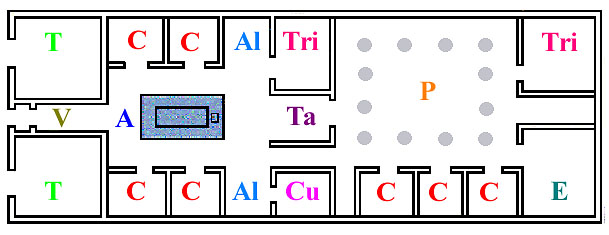|
|
 |
|
Roman Atrium Style Housing |
|
written
by laured / 09.03.2004 |
|
|
| |
Patron |
| |
| |

|
|
| Layout of a Typical Roman Atrium Style Home. |
| Try to locate each room to visualize the purpose it served for the partron |
| |
|
Religious:
Many believe that the art in the Roman Atrium house was displayed not only to impress guests and satisfy its owner, but also to send a deep religious message.
Ancient wall decorations are thought to convey religious and moral beliefs. Decorations often showed the deities of love and fertility, Aphrodite and Dionysus. Less obvious were paintings of landscapes, which were considered sacred. Some scholars believe that still life paintings were offerings to the gods, though others point out the fact that many Romans preferred realistic portraits to serve a different purpose; these expressed the unique personality of the person who was painted.
Sculptures with alleged religious implication were abundant in the Roman Atrium house. Statues of goddesses and gods that symbolized divine perfection were carved throughout houses according to ideals of form and beauty defined by the Greeks. Many households also had household shrine. Here, lares, or statues of the family’s personal deities were thought to protect the house.
Personal:
Sculpture was also used to promote the owner’s status. The wealthiest Roman families imported their sculptures from Greece. The best-studied collection of sculptures comes from the Villa of the Papyri at Herculaneum, where eighty-seven sculptures were recovered. The well-cultured aristocratic owner chose statues ranging from copies of Greek masterpieces, to decorative, but undistinguished pieces.
Political:
One of the most important institutions was clientela. In this very practical system, a wealthy man gave clients financial and legal help in exchange for patron political help. The patron was supposed to regard his clients higher than his own relatives by marriage, and the client was to pay the patron the respect of a parent, nation, or god. The greatest extreme of this relationship occurred when Augustus proclaimed that all Roman citizens were his clients.
Full-length sculptures of emperors were often shipped to all parts of the Roman empire to promote his leadership.
Social:
Status, status, status. The bigger and more ornate one’s house, the more visitors he had. The more social activity focused on his home, the higher his social standing (dignitas). However, there was a conflict. Erecting an elaborate home was considered unworthy by many Romans, yet since it could so significantly increase one’s social standing, many men ignored other’s criticism and built the homes, anyway.
In terms of art within the house, it is believed that the householder’s chief goal was to gain as much as he could and strategically place such art in crucial vantage points to exhibit his wealth. Many works of art had few or no moral implications, and were there only as ostentatious decorations. Such art served only to exhibit or raise the status of the owner.
|
| |
|
| |
|
|
 |
|

